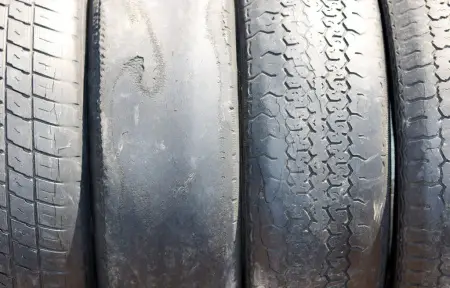
How long can you drive on worn tires? This question comes to the mind of every car driver at some point in their life. The most straightforward answer to this question is that you should drive your car from your home to the nearest tire shop on worn tires to buy new ones. Driving on bald tires can be fatal and can even cause death. So if you are unafraid of death, you can drive on bald tires for as long as you want.
Tires provide you with traction and control while driving. So better tire means excellent performance and safety. But how to know if your tires are worn out (bald) or not? To understand this, you have to measure the tread depth.
What is Tread
Tread is a layer of rubber on the tire that gets tattered with time with usage. You can think of it as the sole of a shoe that can affect your safety while walking.
The standard tread depth of new tires is in the range of 10/32” to 11/32” (excluding exclusive winter tires as they have more depth compared to regular tires). In most American states, the 2/32” tread depth is the limit at which your tires are considered worn out. You might get a ticket if you have bald tires.
The Penny Test
You do not have to be a professional to check the damage level of your tire. In fact, you can use a penny to measure the tread depth, and this method is pretty reliable.
All you have to do is insert a penny upside down in the tread keeping Lincoln’s head to your side. If the penny is embedded deep enough to cover Lincoln’s head, tread depth is fine, but if the head is outside, you should consider buying a new set.
Tread Depth Guage
Another authentic way to check the depth is by using a tread depth gauge. You can buy the tool from a nearby store or an online website. Typical meters can measure from 1/32” to 32/32”. Make sure to check the scale (inch or millimeter) while taking measurements. Moreover, for better results measure all 3 grooves. The lowest value will decide the tread depth.
The Dangers of Driving Bald Tires
A tire loses its gripping power as it wears down.
Driving in Rain
In the rainy season or on wet roads, the primary responsibility of the tread (grooves) is to channel out water. When the tread is not deep enough, your tire does not contact the road properly and loses traction. This is known as hydroplaning and can cause your car to slip.
Driving in Summer
Bald tires get more affected by high temperatures and can even cause blowouts and tire failures.
Driving in Snow
On snowy roads, the low tread depth can make it impossible to control the car. Your car will lose the ability to accelerate and stop.
Increased Chances of Flat
The thin layer of rubber can easily get punctured as there is not much wall between the tire and road.
Bottom Line
Considering all the points, driving on worn tires is not worth the risk.
Same articles

Understanding Vehicle Inspection and Verification Services: Why They Matter for Every Driver
GuidesVehicle inspection and verification services are an essential but often overlooked part of keeping roads safe and cars legally compliant. Most people only think about inspections when it’s...
KLIFEX Brand Overview: High-Quality Automotive Repair Kits for Affordable Repairs
GuidesThe automotive aftermarket has long needed solutions that combine reliability, durability, and affordability. Many car enthusiasts and services are looking for a way...
Fast, Reliable Vehicle Emissions & Inspection Services Made Simple
GuidesFast, reliable emissions and inspection services are essential for keeping vehicles road-ready, compliant with environmental regulations, and safe for daily driving. If you’re looking for quick...

